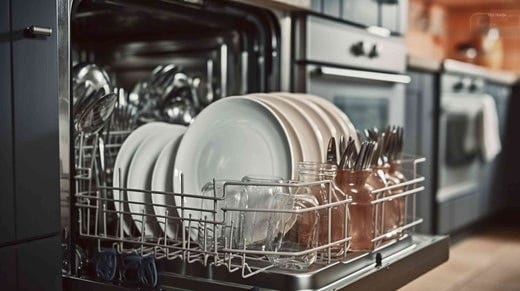
The Most Common Types of Dishwashers

Dishwashers are a must-have item in modern kitchens. They offer countless benefits, such as saving valuable time, energy, and money and keeping dishes looking sparkling clean with minimal effort. As more and more families embrace busy lifestyles, the global demand for dishwashers has surged.
The market now offers an extensive range of dishwashers, each with its unique features and benefits. This variety can be empowering, but it also means that finding the perfect dishwasher for your household can be a daunting task.
Read on to learn about the most common types of dishwashers based on installation, size, and location of controls, so you can find the appliance that best fits your needs.
Types of dishwashers by installation
The built-in dishwasher is generally permanently connected to your home’s plumbing system. Conversely, portable dishwashers are available that require no dedicated connection and simply utilize the kitchen sink faucet.
1. Built-in dishwasher
The most prevalent type of dishwasher is the built-in or under-counter model. These dishwashers usually come in two sizes: the standard 24-inch width and a smaller 18-inch width. They have unfinished sides as they are designed to fit snugly between cabinets beneath a countertop.
Benefits
Doesn't occupy a countertop area and uses very little floor space.
Often includes additional features compared to portable models, like custom washing and drying options, larger capacities than portables, and occasionally an extra rack.
Allows simultaneous use of your kitchen sink and dishwasher since it doesn't need a faucet hookup.
2. Portable dishwasher
This type of dishwasher is perfect for individuals or families living in compact areas, such as city apartments, trailers, or RVs—it is ideal when kitchen space is scarce.
They don’t need any dedicated plumbing connections, so they utilize a faucet adapter that links to the sink instead. They are available in various sizes, ranging from the standard 24-inch model to a more compact 18-inch version and even smaller countertop models.
Benefits
Transport your portable dishwasher wherever you go because they don't require permanent installation.
Some portable dishwashers feature a wooden butcher block-style surface, offering extra countertop space.
Generally, it comes at a lower price compared to built-in dishwashers.
3. Integrated or panel-ready dishwashers
Integrated or panel-ready dishwashers allow you to customize the appearance of your kitchen. These dishwashers can be tailored with exteriors that match your cabinetry, creating a sleeker aesthetic compared to standard dishwashers. However, they necessitate plumbing installation and thus require a permanent spot in your kitchen.
Benefits
Achieve a unified appearance by matching the cabinetry.
Adds a touch of warmth as they lack the industrial aesthetics of standard dishwashers.
Provide comparable features to other built-in dishwashers, allowing you to choose one that suits your family's requirements.
Types of dishwashers by size
When buying a new dishwasher, it's important to think about your household size, available space in your kitchen, and the dishwasher size.
Standard-size dishwasher
Built-in dishwashers typically measure 24 inches wide, 24 inches deep, and 35 inches tall. Multiple models are available, each with a range of features, such as delayed start, quick cycles, and even third racks.
Benefits
- Most prevalent dishwasher size, you'll encounter a wide range of features and prices.
- Perfect for larger families with frequent dish usage and cooking activities.
- You might compromise under-cabinet space, but you'll preserve your countertop area.
Small or compact dishwasher
In cramped areas lacking ample space, compact dishwashers present a viable solution. Despite their smaller size, they can provide features similar to those of full-size dishwashers.
Typically, compact dishwashers measure 18 inches wide, 24 inches deep, and 35 inches tall, although dimensions may vary depending on the model.
Benefits
- Available in various styles and finishes, although the range may not be as extensive as standard-sized dishwashers.
- Compact dishwashers may be priced lower than certain full-sized models, depending on the model and included features.
- Deliver the functionality of a standard dishwasher while requiring less sacrifice in terms of lower cabinet space.
Types of dishwashers by location of controls
Dishwashers are generally available in two styles distinguished by the location of the control panel: front control and top control.
Each style has unique features and advantages, and your choice between the two is entirely based on personal preference. We aim to provide clarity and guidance to help you in your quest about top-control vs. front-control dishwashers and which is the right decision for your needs.
Front-control dishwashers
Front-control dishwashers have their control panels facing forward, making it easy to see and access all the buttons and screens at a glance.
These models usually feature a recessed or integrated pocket handle located below the controls rather than a handle that protrudes from the front.
Benefits
- Program and cycle indicator screen or light is typically visible, eliminating the need to open the dishwasher to check the remaining time.
- Front-control dishwashers can often be more budget-friendly than their top-control counterparts.
- The buttons are easier to reach and use.
Top control dishwashers
Top-control dishwashers feature control panels located discreetly on top of the dishwasher door. The control buttons remain hidden when the door is closed, creating a minimalist and sleek appearance.
Benefits
- Certain models provide handles that can also serve as towel racks.
- This style adds a seamless and integrated appearance to your kitchen.
- Panel-ready versions are also offered in this design.
.png?width=70&height=45&format=png&quality=50)


